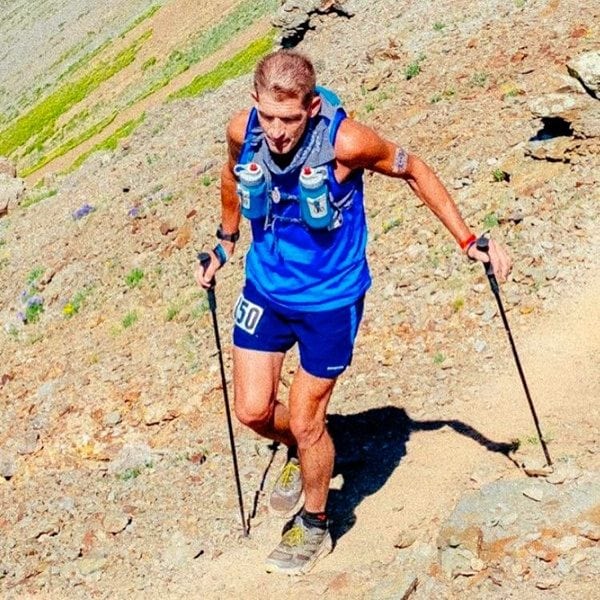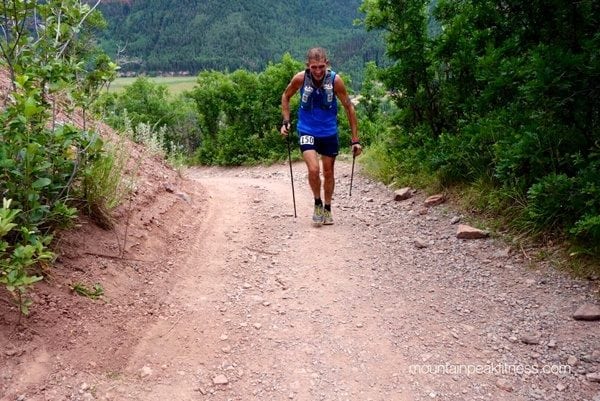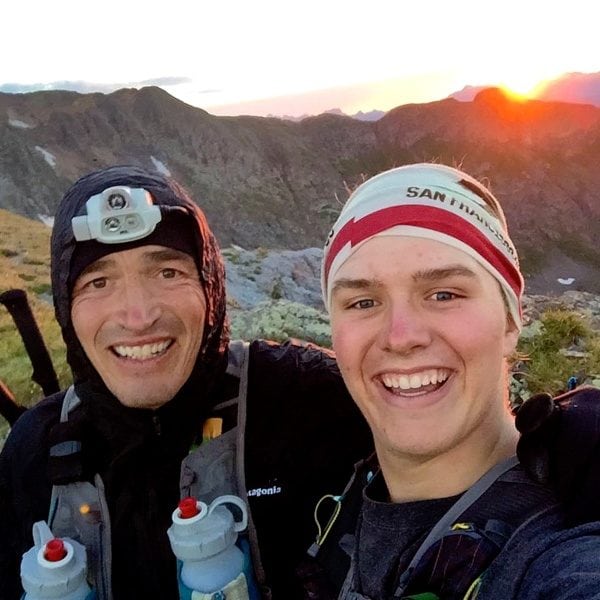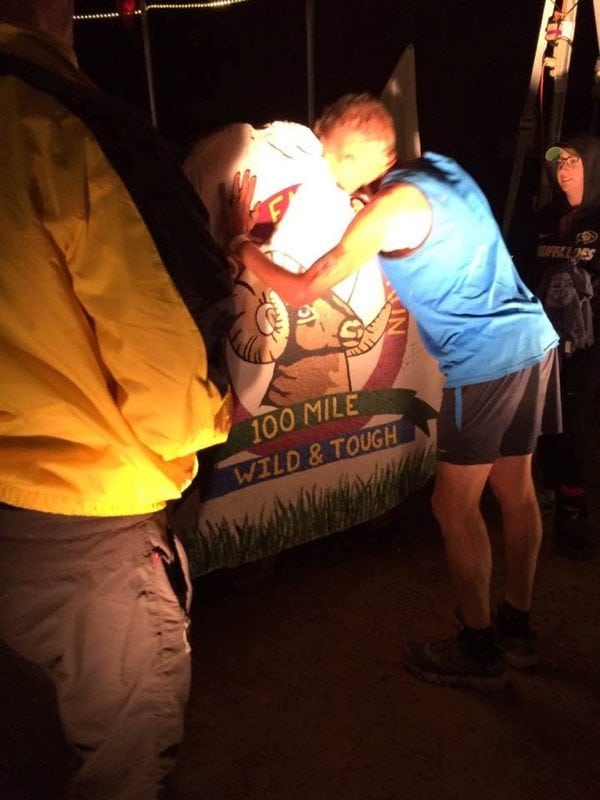[Author’s Note: Last Friday, for the first time in over four and half years, there was not a Friday column here in AJW’s Taproom and I apologize to all of my loyal readers for that. In my anxiety over the start of the Hardrock 100, I simply didn’t have the bandwidth to write a column. I am back at it, however, today, and I hope to not miss another Friday for at least four and a half more years.]
Real real gone
I got hit by a bow and arrow
got me down to the very marrow
And I’m real real gone
Real real gone
I can’t stand up by myself
Don’t you know I need your help?
And I’m real real gone
Some people say
you can make it on your own
Oh, you can make it if you try
I know better now
You can’t stand up alone
Baby, that is why
I’m real real gone.
-Van Morrison
 At about 3 p.m. last Saturday, after covering 91 miles of the Hardrock 100 course in 33 hours, I arrived at the Cunningham Gulch Aid Station scared, shattered, and sad. After a Friday filled with excitement and hope, the night had turned to a whirling pile of despair. I walked slowly down the road stripping off my shirt and dropping my pack by the car. I slumped in a chair and began to cry.
At about 3 p.m. last Saturday, after covering 91 miles of the Hardrock 100 course in 33 hours, I arrived at the Cunningham Gulch Aid Station scared, shattered, and sad. After a Friday filled with excitement and hope, the night had turned to a whirling pile of despair. I walked slowly down the road stripping off my shirt and dropping my pack by the car. I slumped in a chair and began to cry.
I had dreamt of this day for seven months. Recovering from major hip surgery, I had been focused and disciplined in my rehab and recovery. Once I gained back a fair amount of fitness I had committed myself to getting into the best shape that I could. I thought, in the week leading up to the race, that I was as fit as I had ever been. Then, about half way around the most beautiful race course I had ever run, everything began to unravel.

Consistent climbing up Grant-Swamp Pass. Photo: Nicklaus Combs
The first two climbs of the day, Putnam and Grant-Swamp, had gone by uneventfully enough. However, upon arriving into Chapman Gulch at mile 18.1, I felt anxiety creeping into me. I wasn’t tired, just uneasy. My normally calm demeanor was being taken over by panic. I am not sure why, but self-doubt was beginning to surface in my mind.

Anxiety creeps into Chapman. Photo: Leon Lutz
I tried to relax on the long steady climb up Oscar’s Pass. I fell into stride with a small group and tried to enjoy the scenery. I was attempting to will myself back to hope, but melancholy dominated. Understanding that side of me well, I knew that digging out of this hole would be difficult if not impossible. On the long descent into Telluride I could not find a rhythm, I fell twice, and seemed to be unsteady on my feet and unfocused in my brain. Arriving in Telluride I felt completely off my game.

The melancholy climb up Oscar’s. Photo: Joe Azze
Even on a good day, leaving Telluride is difficult as I knew I was facing the prospect of the long, and this year, hot, climb up to Virginius Pass. I took solace in the fact that good friends Roch Horton, Jared Campbell, and Ty Draney were awaiting me up there, but it didn’t seem to help keep the fatigue from pouring inexorably into my body. Nothing hurt, everything was just slowing down and becoming more labored.
From the top of Virginius, I enjoyed the snow and scree slide down to Governor’s Basin and after a quick stop at the aid station I really did enjoy the seven-mile road descent down Camp Bird Road into Ouray. Once in Ouray, I tried to convince myself I was coming back to life. I arrived there at 6 p.m. on the dot, so was pleased with that split and after fueling up a bit I was looking forward to jumping back on the trail with my pacer and good friend Scott Wolfe. Scott has paced me on some of my best days, so I was hopeful that his positive spirit and great sense of humor would help me turn a corner. And, for a couple of hours, it did.
The long steady climb out of Ouray and up along the Bear Creek Trail was fun. The sun was beginning to settle behind the ridge to the west and the running was smooth. Scott and I chatted away and as the sky darkened we arrived at the Engineer Aid Station (mile 51.5). It was shortly before 9 p.m. and I was thrilled to see several familiar faces as Timothy Olson, Nick Coury, Scott Jaime and Scott’s pacer, Darcy Piceu were all there. My melancholy spell subsided quickly as the thought of running the next few hours with friends emerged.
After a nice big snack, Scott and I set our sights on the climb up Engineer Pass. We kept a steady pace throughout the climb and maintained contact with the sets of lights ahead. Upon cresting the pass we were ready to make time on the descent into Grouse Gulch. Sadly, my body, most specifically my legs, had other ideas. As I attempted to settle into my downhill running stride my hamstrings locked up. It was a feeling I had never felt before. I popped an S! cap, downed a bottle of water, and walked a bit. “Maybe I was a little crampy?” A few minutes later I tried to run again. Same deal. Locked up legs. Damn!
Scott did his best to cajole me down the nice smooth road to Grouse Gulch, but to no avail. When I arrived at the aid station (mile 58) I was discouraged and spent. And my three friends were beginning their ascents up 14,000 foot Handies Peak. Once again, I needed to re-group. I entered the aid station and slumped in a chair, grabbed some soup, and began to mutter to my crew. After about five minutes I thought I was ready to get going, but after standing up and putting my pack on I did something I’ve never done in 31 other 100-mile races, I said I wasn’t ready to go yet and sat back down. Clearly, something was awry. Shelly and the boys did their best to keep me positive, and, eventually, we began talking about changing expectations, but it was clear that much of the levity of the day was gone.
A decade or so ago, while running the Wasatch 100 Miler in Utah, I spent the middle part of the day running with the late Dave Terry. Dave was a 10-time Western States and Wasatch finisher and one of the great ultra running dudes of the ’90’s. That year at Wasatch, as we were cresting Bear Ass Pass at about mile 58, Dave said something to me I’ll never forget. He said,
“You know what AJ? One thing ultrarunning has taught me about life is that we always need to be willing to adjust our expectations. That’s what I am going to do right now.”
And with that, Dave slowed to a walk and ran the last 42 miles of the race on his own terms and in his own way.
As Scott and I began the long hike up Handies, I thought back to Dave’s comment all those years ago and began to adjust my expectations for the day. And, not only that, in the midst of the dark and the cold of the stunning San Juan Mountains, I reflected on my life outside of running as well.
Where did I need to adjust my expectations?
What were the answers I was looking for?
How could I turn devastating negatives into constructive positives?
This disassociation didn’t necessarily help me climb any faster, but it did give me a bit of solace to know that even in the midst of great suffering, ultrarunning could be there as my teacher. And, man, at this moment, I really needed a teacher!
Scott and I finally reached the summit of Handies three hours after leaving Grouse and we picked our way down the trail to Burrows Park (mile 67.5). After a relatively brief stop there we made our way down the road to Sherman. A few steps into this leg I knew there was no run left in me. Even on the relatively smooth downhill of this buffed out road, I was reduced to a wheezy walk. And so we walked. Arriving at Sherman right around 5:45 a.m. I thought, “OK, just under 24 hours to go 72 miles. Not terrible. Maybe we can salvage a decent finish.”
I enjoyed Sherman. The volunteers were great, the food and drink delicious, and the Forest Service bathroom had been transformed into a palace. When we rolled out of there at exactly 6 a.m., I felt rejuvenated. We had 28 miles to go. Anyone can run 28 miles, right?
The first two miles of the climb up to Pole Creek went well, but, then, somehow things went awry. Above treeline I began to labor and as we made our way out into the large grassy basin of Pole Creek I began to panic a bit. For the first time in my entire ultra career I asked myself, “Can I finish?”
At long last we arrived at the Pole Creek Aid Station (mile 80.4) and wolfing down a couple of eggs seemed to help adjust my attitude. The nice volunteers bantered with Scott and I as we gulped down some coffee and prepared for the climb up and over to Maggie Gulch. I knew this one was going to test my mettle, but at this point I convinced myself I had no other choice. Unless something tragic happened, I was going to walk this thing in.
In short, the trip over to Maggie Gulch (mile 85) was absolutely brutal. Two and a half hours to go 4.3 miles. Looking back on it now, I am not sure how I did it but I got there. Somewhere along this stretch I developed a rhythm of walking 2 minutes and resting 30 seconds and, then, just repeating that over and over again. Any time I tried to keep moving for longer than two minutes at a time I was overcome with fatigue and my legs threatened to stop working. So, I just did whatever I could do.
Scott and I sat in Maggie Gulch for about 10 minutes doing what had become a usual routine by now; eating, drinking, whining, asking how far to the next aid station and how much climbing was left. At this point, however, I knew full well what lay between me and seeing my crew at Cunningham Gulch; 6.1 miles, 1,700 feet of ascent and 3,250 feet of descent. And there was only one way to get there.
Three excruciatingly long hours later I stumbled into Cunningham Gulch (mile 91) and met my family: my wife Shelly, and my three sons Carson, Logan, and Tully. Scott had a quick chat with Shelly and I sat down to cry. We circled the wagons by our car and just talked. Oddly, having finally arrived in Cunningham, 33 hours after the start, I felt calm. I just had no idea how on earth I was going to drag myself 3,000 more feet over Dives-Little Giant and on to Silverton, simply no idea.
Shelly started handing me hot dogs, which I wolfed down, someone else handed me an ice cold Coke and Logan began to take off my shoes and socks. Tully, my 13 year old, said simply, “Dad, you are going to do this!” After getting the food down it was decided that a nap would be a good idea. Jack Bolan, a friend from Richmond, Virginia who had driven all the way out to volunteer, set me up with a mattress and a sleeping bag and I quickly collapsed. 45 minutes later Logan, my 16-year-old, woke me up. He wanted a chance to talk just to me before the others got there to tell me the plan.
“Dad,” he said, “One of your biggest problems is you worry about unimportant stuff all the time. For the next few hours all you need to worry about is getting over that damn mountain.” Seven hours later, unbeknownst to me at the time, Logan posted the following on his Facebook page:
“My dad just redefined suffer. Andy Jones-Wilkins swallowed his pride and stuck it to the finish of the hardest race of his life. He inspires me and I am so proud to call him my dad!”
The rest of the crew came into the tent and the finish plan was hatched. Carson, my eldest son, all 5’10” and 215 pounds of him, was going to pace me to the finish. Born with a heart of a lamb and the spirit of a lion, Shelly made the executive decision that Carson should be the one. And he most certainly was the right choice. As we embarked on that inexorable march up Little Giant, Carson was there behind me at each excruciatingly small step. He cheered me up when I needed cheering, cajoled me into standing up when I took a bit too long of a rest, and made me feel like there was no doubt whatsoever that we would make it to Silverton. After parenting him for 18 years Carson was, in three short hours, returning the favor. I’ll never forget it. Ever.

With Carson the Caretaker. Photo: Carson Jones-Wilkins
The descent down to Silverton, while long and slow, was a bit of a blur. Once summiting Little Giant we knew we were going to finish and it truly was just a matter of putting one foot in front of the other. Many runners streamed past us as we picked our way down the roads and trails outside Silverton and once we made it back to town, across the bridge and onto 14th Street, I was filled with gratitude. In seconds, the melancholy cloud lifted and I ran a few strides up the street and down the chute to that special kiss of the rock.

Kissing the rock. Photo: Dominic Grossman
And, just like that, 41 hours and 51 minutes after I started, the most difficult run of my life was over. I will be learning from this one for years.
Bottoms up!

Post-race chat with Kilian. Photo: iRunFar/Bryon Powell
AJW’s Beer of the Week
 This week’s Beer of the Week comes from a great brewery in one of the four historic Hardrock mining towns, Telluride, Colorado. Telluride Brewing Company’s Bridal Veil Rye Pale Ale, named after the stunning waterfall that towers over town, is a nice, balanced Rye Pale Ale that goes down smooth on a warm summer evening and pairs well with just about anything.
This week’s Beer of the Week comes from a great brewery in one of the four historic Hardrock mining towns, Telluride, Colorado. Telluride Brewing Company’s Bridal Veil Rye Pale Ale, named after the stunning waterfall that towers over town, is a nice, balanced Rye Pale Ale that goes down smooth on a warm summer evening and pairs well with just about anything.
Call for Comments (from Bryon)
- Share stories of your race-gone-wrong that you survived… and what you got out of it!
